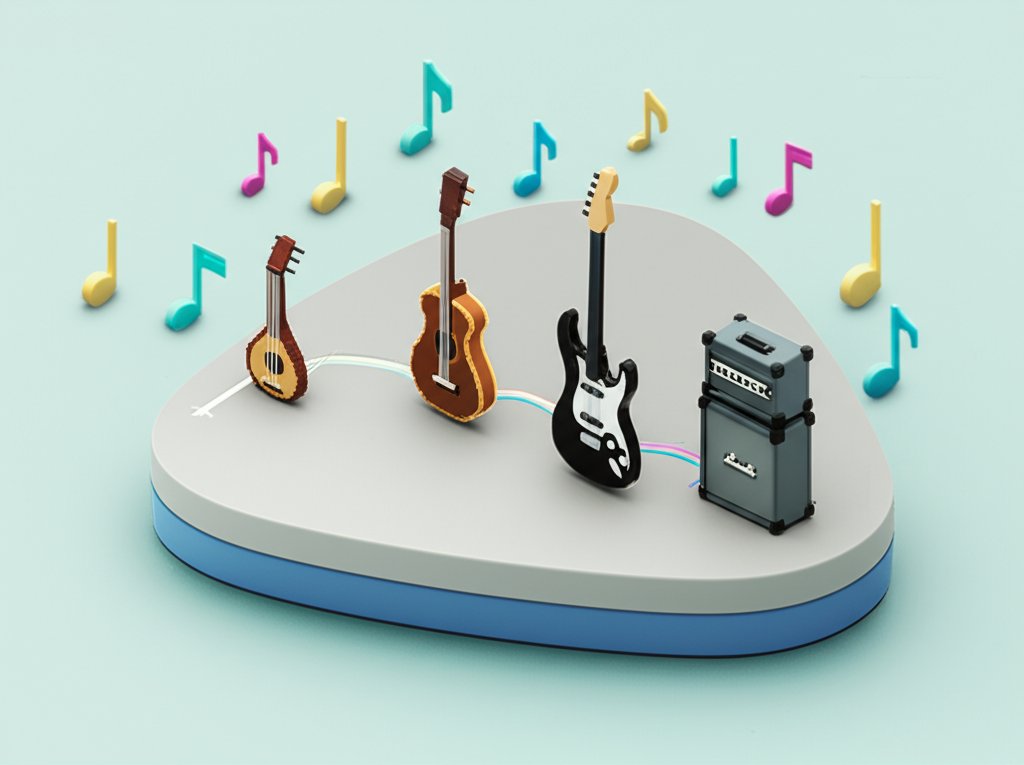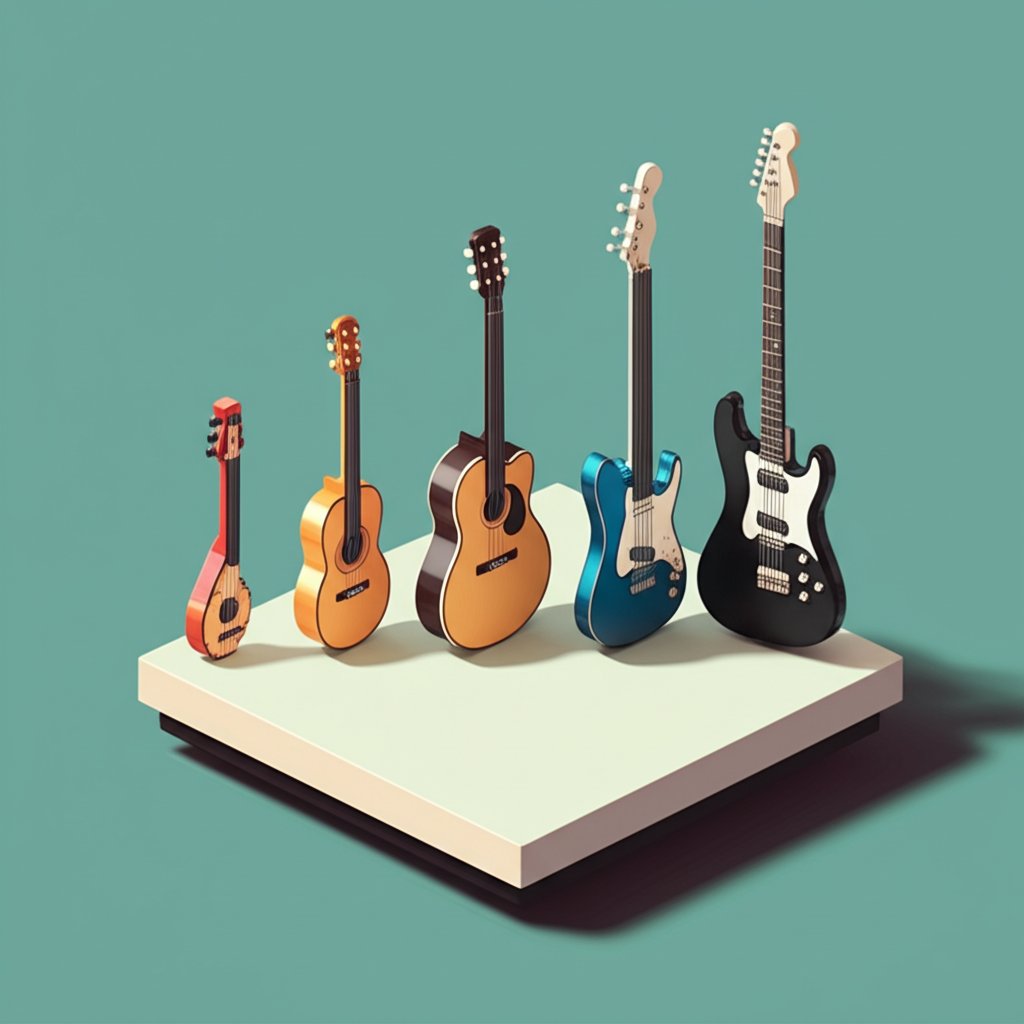Welcome, music lovers and history enthusiasts, to an unparalleled journey through time, exploring the profound sejarah gitar (history of the guitar) and its astounding evolusi gitar (evolution of the guitar). Few instruments have captivated the human spirit and shaped the soundscapes of our world quite like the gitar. From its ancient origins as a simple stringed device to the complex, electrifying instrumen gitar we know today, its story is a testament to human ingenuity, artistic expression, and enduring passion for musik gitar (guitar music).
In this comprehensive guide, we’ll peel back the layers of centuries, uncovering the fascinating transformations, pivotal innovations, and legendary figures who have sculpted this iconic instrument. Prepare to be immersed in the rich narrative of the guitar – an epic saga that continues to unfold.
The Ancient Roots of the Gitar: Tracing Early Stringed Instruments
Understanding the gitar’s evolution also provides context for broader musical trends, allowing us to appreciate the deep connection between the instrument’s journey and the history of music genres worldwide.
The journey of the gitar did not begin in 16th-century Spain, as often cited for the modern instrument, but stretches back millennia. Its fundamental concept – stretched strings vibrating over a resonator – is remarkably ancient, echoing across diverse cultures and civilizations. To truly appreciate the sejarah gitar, we must first look to its distant ancestors.
From Kithara to Lute: Precursors to the Modern Gitar
Ancestral instruments resembling the gitar have existed for over 4,000 years. One significant etymological link traces the word “guitar” back to the ancient Greek word kithara (κιθάρα), a harp-like lyre. While structurally different, the kithara was a prominent stringed instrument in ancient Greece, used for accompanying poetry and song, much like the gitar would centuries later.
Across Mesopotamia, Egypt, and Persia, various long-necked lutes and tanburs flourished. These instruments, typically featuring a small body and a long fretted neck, shared a direct lineage with the lutes that would eventually make their way into Europe. The transmission of these ideas, often through trade routes and cultural exchange, laid the groundwork for the instrument’s future evolusi gitar.
Early Stringed Instruments Across Cultures
The concept of a resonant box with strings stretched over it for musical expression is universal. In Central Asia, the dutar and setar (meaning two strings and three strings, respectively) were common long-necked lutes. In the Indian subcontinent, instruments like the sitar evolved, showcasing complex fret systems and resonant bodies. These diverse instruments, while not direct “guitars,” cemented the idea of a plucked string instrument with a neck and frets, a design principle crucial to the development of the instrumen gitar.
The Arabic oud, a fretless lute with a deep, pear-shaped body, played a particularly vital role in the sejarah gitar. Introduced to Europe during the Islamic Golden Age, particularly in Moorish Spain (Al-Andalus), the oud significantly influenced the development of European stringed instruments, including the medieval lute and, eventually, the gitar. This cross-cultural pollination highlights the global tapestry from which the gitar emerged.
The Birth of the Modern Gitar in Europe: Renaissance and Baroque Eras
The true genesis of the instrument recognizable as a gitar began in Europe, specifically in Spain, during the Renaissance. This period saw a refinement of design and a consolidation of features that would define the instrument for centuries to come.
The Vihuela and the Spanish Gitar (16th Century)
In 16th-century Spain, the vihuela was a highly sophisticated stringed instrument, sharing many characteristics with the later gitar. It was typically double-strung (courses of two strings) and fretted, played with a plectrum or fingers. At the same time, a simpler, four-course instrument known as the “Spanish gitar” (or guitarra) began to gain popularity among the common people. While the vihuela was for the aristocracy, the smaller, more portable Spanish gitar was adopted for popular songs and dances.
This 16th-century Spanish gitar marked a crucial turning point in the evolusi gitar. It typically had four courses of strings, tuned similarly to the first four strings of a modern guitar, and was often played strummed. Its accessibility and lively sound contributed to its widespread adoption, contrasting with the declining popularity of the more complex lute.
Baroque Gitar: Expanding Versatility and Reach
The 17th century ushered in the Baroque era, a period of dramatic artistic expression that profoundly influenced the instrumen gitar. The Spanish gitar evolved, typically gaining a fifth course of strings, making it a five-course instrument. This Baroque gitar became immensely popular across Europe, especially in Spain, Italy, and France. Composers like Gaspar Sanz and Robert de Visée wrote extensive suites and dances for the instrument, showcasing its increased melodic and harmonic capabilities.
The body shapes became more refined, often featuring ornate inlays and rosettes. This period cemented the gitar’s role as a versatile accompaniment instrument, capable of both delicate harmony and rhythmic drive. The English, German, and French words for “guitar” (Gitarre, Guitare) all trace their origins back to the Spanish guitarra, underscoring its historical significance and ability to transcend borders.
The Classical Gitar Emerges (18th-19th Century)
By the late 18th century, the Baroque gitar underwent further transformation. The double courses of strings gradually gave way to single strings, leading to the six-string configuration we are familiar with today. The body size increased, and fan bracing for the soundboard was introduced (credited to the Spanish luthier Antonio de Torres Jurado in the mid-19th century), significantly enhancing the instrument’s volume, sustain, and tonal balance. This new form was known as the classical gitar.
The early 19th century saw a flourishing of the classical gitar, with composers like Fernando Sor and Mauro Giuliani creating a vast repertoire that elevated the instrumen gitar to a concert-stage instrument. However, towards the end of the 19th century, its popularity waned somewhat, overshadowed by larger orchestral instruments. It was the legendary Spanish guitarist Francisco Tárrega who revitalized interest in the classical gitar, pioneering new techniques and compositions that brought it back into the spotlight, laying the groundwork for its resurgence in the 20th century.
Industrial Revolution & Evolusi Gitar: From Acoustic to Electric Marvels
The 20th century brought unprecedented change to the gitar, fueled by technological advancements and shifting musical tastes. This era saw the instrument transform from a primarily acoustic presence to an electrified powerhouse, fundamentally altering the landscape of musik gitar.
The Rise of the Steel-String Acoustic
As music evolved in the American South, particularly with the birth of blues and country music, musicians needed a louder, more cutting instrumen gitar to compete with banjos, fiddles, and brass instruments. The delicate gut strings of the classical guitar were replaced with steel strings, which offered greater volume and a brighter, more assertive tone. This innovation led to the development of the steel-string acoustic gitar.
Early pioneers like C.F. Martin & Company and Gibson Guitars began producing robust flat-top acoustic guitars designed for steel strings, often with larger bodies to project sound. This design, particularly the dreadnought shape, became a staple for folk, country, and blues musicians throughout the 20th century. The sheer power and versatility of the steel-string acoustic profoundly influenced the kinds of musik gitar that could be created.
Jazz and the Archtop Gitar
In the 1920s and 30s, as jazz music soared in popularity, a new type of acoustic gitar emerged: the archtop. Inspired by violin construction, archtop guitars featured carved, arched tops and backs, often with f-holes, providing exceptional projection and a punchy, articulate tone. Brands like Gibson (with models like the L-5) and Epiphone became synonymous with these instruments, which allowed guitarists to cut through big band arrangements with their solos and rhythmic chords.
The archtop was a critical stepping stone in the evolusi gitar, showcasing the instrument’s adaptability to new musical demands and setting the stage for the next monumental leap: amplification.
Electrification: The Game-Changer in Musik Gitar
The most revolutionary development in the sejarah gitar was its electrification. Acoustic guitars, even archtops, struggled to be heard in larger ensembles or noisy venues. Experiments with electromagnetic pickups began in the 1920s, culminating in the first commercially successful electric guitars in the 1930s. “Frying pan” National and Electro Hawaiian guitars were among the early amplified instruments, initially intended for Hawaiian slide guitar.
The addition of magnetic pickups, which convert string vibrations into electrical signals that can be amplified, unleashed an entirely new realm of sonic possibilities. This innovation didn’t just make the gitar louder; it allowed for sustain, feedback, and tonal manipulation previously unimaginable, forever changing the sound of musik gitar.
Solid-Body Innovations: Fender and Gibson
The 1950s solidified the electric gitar’s dominance with the introduction of the solid-body electric guitar. Companies like Fender and Gibson were at the forefront. Leo Fender’s Telecaster (1950) and Stratocaster (1954) offered sleek, durable designs with bright, articulate tones. Gibson countered with the iconic Les Paul (1952), known for its rich, warm sustain.
These solid-body instrumen gitar eliminated acoustic feedback issues at high volumes, allowing for even greater amplification and the use of distortion, tremolo systems, and other effects. This period was a true explosion in the evolusi gitar, moving it from an accompaniment role to the central, commanding voice in countless musical genres.
The Gitar as a Cultural Icon: Impact on Musik Gitar and Genres

The electric gitar, in particular, did more than just change music; it became a symbol of rebellion, youth culture, and artistic freedom. Its impact on musik gitar and popular culture is immeasurable.
Rock ‘n’ Roll Revolution: The Electric Gitar Takes Center Stage
The mid-20th century saw the electric gitar become the undisputed voice of rock ‘n’ roll. From Chuck Berry’s iconic riffs to Elvis Presley’s stage presence, the gitar was central to this cultural phenomenon. It provided the raw energy, rhythmic drive, and melodic hooks that defined the genre. The 1960s and 70s further solidified this, with legendary guitarists pushing the boundaries of what the instrumen gitar could do.
Jimi Hendrix, with his psychedelic tones and virtuosic improvisation, fundamentally redefined electric musik gitar. Eric Clapton’s soulful blues interpretations, Jimmy Page’s heavy riffs and elaborate solos with Led Zeppelin, and Eddie Van Halen’s groundbreaking two-hand tapping technique all showcased the incredible versatility and expressive power of the gitar. These artists and countless others didn’t just play the instrument; they became synonymous with its sound and spirit.
Folk, Blues, and Acoustic Gitar Revival
While electric guitars dominated rock, the acoustic gitar continued its vital role. The folk revival of the 1960s brought artists like Bob Dylan and Joan Baez to prominence, using the acoustic instrumen gitar as a powerful tool for storytelling and protest songs. The blues, the very foundation of rock ‘n’ roll, continued to thrive with acoustic masters like Robert Johnson and B.B. King demonstrating the raw, emotional depth achievable with just a voice and a gitar.
Today, the acoustic gitar remains a cornerstone of singer-songwriter genres, country, folk, and even contemporary pop, proving its timeless appeal and ability to connect directly with listeners.
The Instrumen Gitar in Modern Music: From Metal to Pop
The gitar’s adaptability is its greatest strength. Throughout the latter half of the 20th century and into the 21st, it has seamlessly integrated into virtually every new musical genre. In heavy metal, the gitar became the primary engine for aggressive riffs, soaring solos, and raw power. In jazz fusion, it took on complex harmonic and improvisational roles. In pop, R&B, and hip-hop, it provides melodic hooks, rhythmic textures, and iconic samples.
The evolusi gitar is ongoing, with new innovations in digital modeling, effects processing, and hybrid instruments continually expanding its sonic palette and role in contemporary musik gitar.
Bass Gitar: The Rhythmic Foundation
No discussion of the gitar would be complete without acknowledging its low-end counterpart: the bass gitar. Developed in the 1930s and popularized by Fender in the 1950s, the electric bass replaced the cumbersome upright bass in many genres, offering easier portability, amplification, and fretted playability.
The bass gitar became the rhythmic and harmonic backbone of rock, funk, jazz, and pop music, providing deep, resonant tones that anchor the band. It is an instrumen gitar in its own right, vital for creating the groove and foundation that allows other instruments to shine.
The Art of the Instrumen Gitar: Craftsmanship and Player Innovation
Beyond its historical journey, the gitar itself is a marvel of design and engineering, constantly refined by luthiers and transformed by the artists who play it.
Materials and Construction: Shaping Sound
The choice of materials profoundly impacts the sound of an instrumen gitar. For acoustic guitars, solid tonewoods like spruce, cedar, mahogany, rosewood, and maple are meticulously selected for their resonant qualities. The bracing patterns inside the soundbox, the shape of the body, and the type of neck joint all contribute to the instrument’s unique sonic fingerprint.
Electric guitars, while less dependent on body wood for resonance, still benefit from quality materials for sustain and tone. Pickups, wiring, and hardware components like bridges and tuners are critical. The continuous innovation in these areas reflects the ongoing evolusi gitar, as craftsmen strive for perfection in playability and sound.
Tuning and Technique: Mastering the Gitar
Tuning a gitar is the fundamental step to producing harmonious melodies. Adjusting the tension of the strings using tuning pegs ensures that the instrument produces precise pitches. While standard tuning (E-A-D-G-B-E) is most common, various alternative tunings (open tunings, drop tunings, etc.) are employed by guitarists across genres to achieve specific sounds and facilitate certain playing styles.
Mastering the gitar involves a blend of technical skill and artistic expression. Techniques like strumming, fingerpicking, bending, vibrato, slide playing, tapping, and intricate arpeggios are all part of the vast lexicon of gitar playing. Each technique, developed through the sejarah gitar, contributes to the rich tapestry of musik gitar.
Legendary Gitar Players and Their Enduring Legacy
Throughout its rich sejarah gitar, countless musicians have left an indelible mark:
- Django Reinhardt: A pioneering jazz guitarist who, despite a severe hand injury, developed an entirely new, virtuosic style.
- Andrés Segovia: The grand master who elevated the classical gitar to international concert halls in the 20th century.
- Les Paul: An innovator in guitar design, recording techniques, and multi-track recording, his name became synonymous with a legendary Gibson gitar.
- B.B. King: The “King of the Blues,” whose singular tone and emotive vibrato made his instrumen gitar, Lucille, famous worldwide.
- Jimi Hendrix: Revolutionized the electric gitar with his experimental use of feedback, distortion, and wah-wah pedals, setting a new standard for rock musik gitar.
- Eric Clapton: Known for his soulful blues playing and iconic status in rock history, often called “God” by his fans.
- Jimmy Page: The architect of Led Zeppelin’s sound, his innovative riffs, multi-tracking, and use of various tunings showcase the gitar’s versatility.
- Eddie Van Halen: A virtuoso whose two-hand tapping technique and blistering solos redefined hard rock and metal musik gitar.
These guitarists, and many more, have not only pushed the boundaries of the instrumen gitar but have etched their names into sejarah gitar, inspiring generations of musicians and forever shaping the evolusi gitar.
Conclusion: The Gitar’s Timeless Resonance

From its ancient ancestors played thousands of years ago to the sophisticated electric and acoustic models of today, the sejarah gitar is a vibrant narrative of innovation, cultural exchange, and profound artistic impact. The continuous evolusi gitar reflects humanity’s unending quest for new sounds and expressions.
The gitar has proven itself to be more than just an instrument; it is a canvas for emotion, a voice for generations, and a constant companion throughout the diverse tapestry of musik gitar. Its journey is far from over, with luthiers, musicians, and technologists continuing to explore its potential. As an instrumen gitar, it remains an enduring symbol of creativity, passion, and the universal language of music.
FAQ: Your Questions About the Guitar Answered
Q1: What is the earliest known ancestor of the gitar?
While the exact direct ancestor is debated, instruments resembling the gitar have existed for over 4,000 years, with ancient long-necked lutes and instruments like the Greek kithara being among the earliest known precursors.
Q2: When and where did the modern gitar as we know it originate?
The modern gitar, particularly the six-string configuration, began to take shape in 16th-century Spain, evolving from instruments like the vihuela and the four-course Spanish gitar, and then further refined in the Baroque and Classical eras.
Q3: What was the biggest innovation in the evolusi gitar?
The electrification of the gitar in the 20th century, particularly the development of magnetic pickups and solid-body designs, is widely considered the most significant innovation, allowing for unprecedented volume, sustain, and tonal manipulation.
Q4: What are the main types of gitar today?
The primary types of gitar today include:
Q5: Who invented the guitar pick?
While people used various objects to pluck strings for centuries, the modern guitar pick, made from celluloid, was famously mass-produced and popularized by D’Andrea USA starting in 1922, making it a common accessory for the instrumen gitar.
Q6: How has the gitar influenced different genres of musik gitar?
The gitar has profoundly influenced nearly every genre. It was central to the development of blues and jazz, spearheaded the rock ‘n’ roll revolution, became the voice of folk music, and remains a core instrumen gitar in pop, country, metal, R&B, and many other contemporary styles. Its adaptability allows it to provide rhythm, melody, harmony, and raw power.










